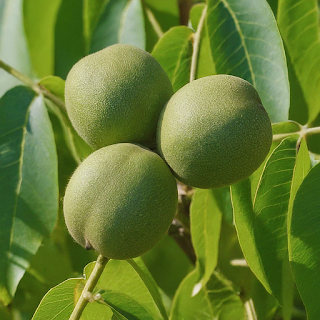Description of the Black Walnut (Juglans nigra):
General Characteristics
--Large, deciduous tree reaching heights of 50-75 feet, with some specimens reaching up to 150 feet.
--Broad, spreading crown with a rounded shape in open areas and an umbrella-like shape in forests.
--Dark, furrowed bark that becomes increasingly textured with age.
--Single, well-formed trunk that is usually branch-free for a considerable distance from the ground.
Leaves
--Large, pinnately compound leaves, reaching up to 2 feet in length.
--Composed of 5-11 pairs of leaflets along a central axis, with a single leaflet at the tip.
--Leaflets are ovate-oblong to ovate-lanceolate with an acuminate tip and a rounded base.
--Edges are irregularly serrated.
--Yellow-green in color, with a strong, pleasant fragrance when crushed.
Flowers and Fruit
--Inconspicuous flowers in elongate, green clusters that appear in spring.
--Produces round, walnut fruits, 1.5 to 2.25 inches in diameter.
--Fruits consist of a hard-shelled, furrowed nut encased in a green husk that darkens as it ripens.
Other Features
--Native to Eastern North America, found from southern Ontario to Texas and Florida.
--Prefers full sun for optimal growth and nut production.
--Shade intolerant, meaning it struggles to grow in dense shade.
--Considered a pioneer species, often found along roadsides, fields, and forest edges.
--Prized for its valuable, dark-grained wood used in furniture, gunstocks, and veneer.
--Produces edible nuts with a distinctive flavor, although the shells are harder to crack than English walnuts.
Interesting historical fact:
Black Walnut trees have been valued for their wood since colonial times and some prized trees have even been stolen.


























